
4 tips to mitigate legionella "harbors" in the mechanical room
Dennis Whitelaw
Owner / President Towle Whitney LLC
800-807-9827
dennis@towle-whitney.com
towle-whitney.com
BOOSTERS, BACKFLOW, AND LEGIONELLA SERIES
Because biofilms, scale, and sediment containing legionellae and other pathogens actually starts in the mechanical room, mitigating these no-flow / slow-flow stagnant water “harbors” is a great start to a successful water management program:
- Over-sized backflow prevention assemblies
- Unattended strainers
- Over-sized expansion tanks with small feed lines
- Booster pumps with large pumps that never run
1) Backflow Prevention Assemblies (Backflow Preventers)
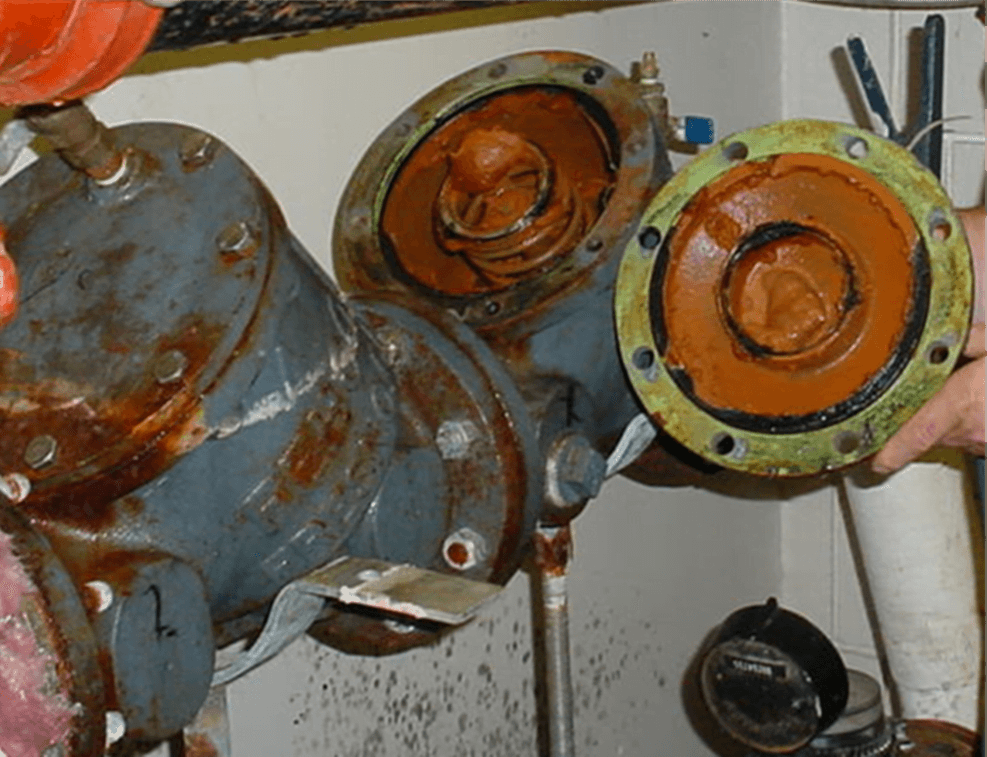



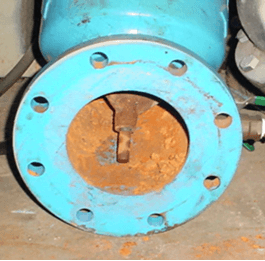

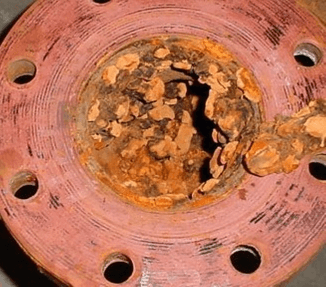

My apologies, as these older pictures are a bit grainy, but they illustrate the “not-so-glamorous” inside of backflow prevention assemblies. Some call it biofilm and scale, plumbers use a different name.
Historically, a building’s supply piping would have a “line-size” backflow prevention assembly, i.e. a 3” backflow preventer on a 3” line.
For the majority of our clients (hotels, office building, multi-family, dormitories, etc.), the water usage (and velocity) through a 3″+ service is much lower than calculated (confirmed by the IPC 2012 Code and Commentary), meaning the piping and backflow preventer tend to be OVER-SIZED.
Since the backflow preventer is located in a warm mechanical room, the cold water’s temperature will rise in a low-velocity (slow-flow) scenario, which invites sediment build-up, scale, bio-films, and pathogens/bacteria (legionella).
The IPC defines this as “UNSAFE PLUMBING”, which requires a remedy.
The problem gets even WORSE with two (large diameter) backflow preventers plumbed in parallel, as the hydraulics will usually force one of the backflow preventers into a no-flow / slow-flow situation.
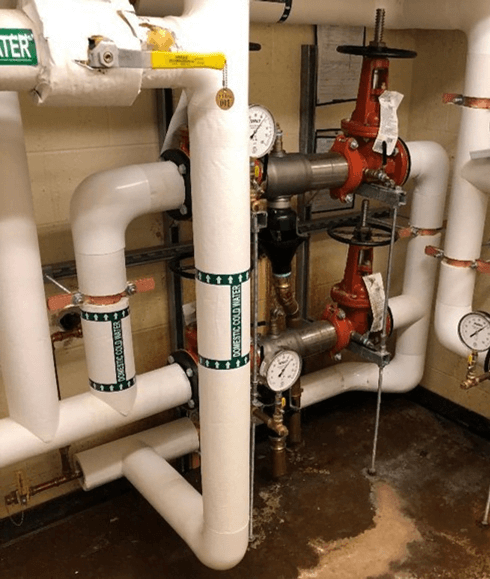

In the above picture, the cold water has two paths through the backflow preventers:
- Bottom backflow preventer: water travels in a straight line (left to right).
- Top backflow preventer: water travels thru three 90° turns.
Unless the bottom backflow preventer has a much higher head-loss, the water will typically all travel through the bottom backflow preventer. The top stainless steel backflow preventer with iron gate valves will see “heat gain by cold water”, as the no-flow / slow-flow will cause stagnant water, leading to pathogens/bacteria (legionella) breeding “harbors”.
WORSE Case Scenario: When the bottom backflow preventer is isolated and tested, the building’s water demand will ALL flow through the top backflow preventer, sending all of the “unsafe” water into the building. It will take a top-notch investigator to tie any sickness and outbreaks to the backflow preventer testing.
TIP: Replace large (3”+) backflow preventers with small PARALLEL backflow preventers
Before
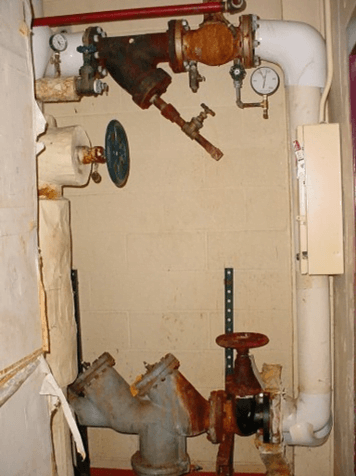

After
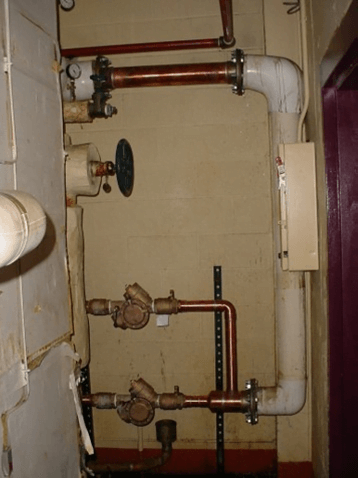

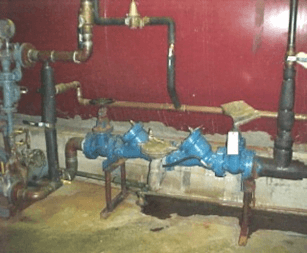

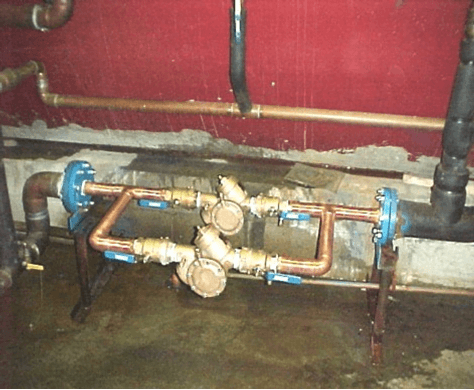

TIP: Install GEN-5 booster w/ integral backflow preventers in parallel
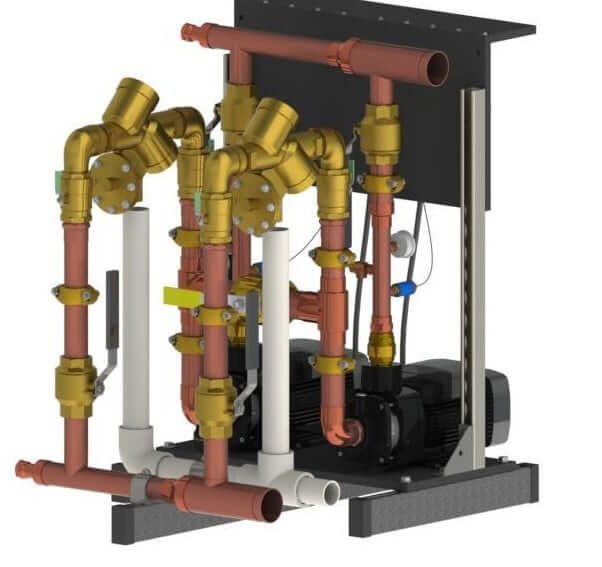

Both solutions:
- Cause water to flow through the parallel (2″) backflow preventers.
- The higher velocities mitigate sediment build-up, scale, bacteria, and bio-film.
- The 2” backflow preventers can be also be tested independently, with huge benefits:
- The building water supply does not have to be shut down.
- Tenants don’t need to be notified (huge time saver).
2) Strainers
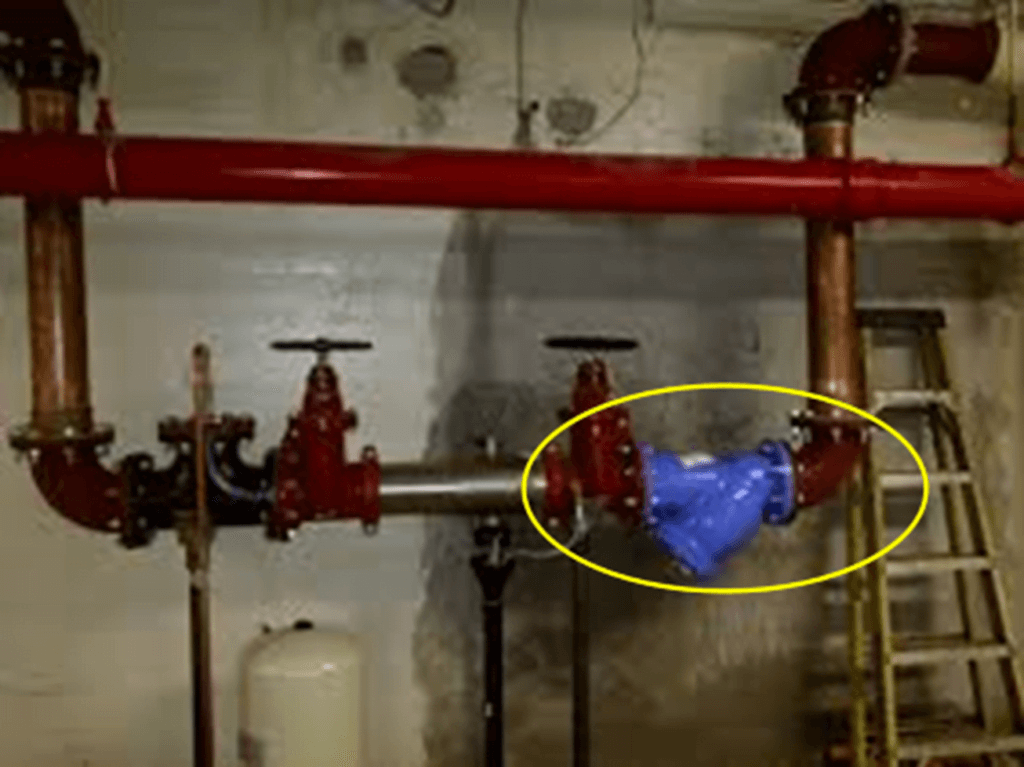

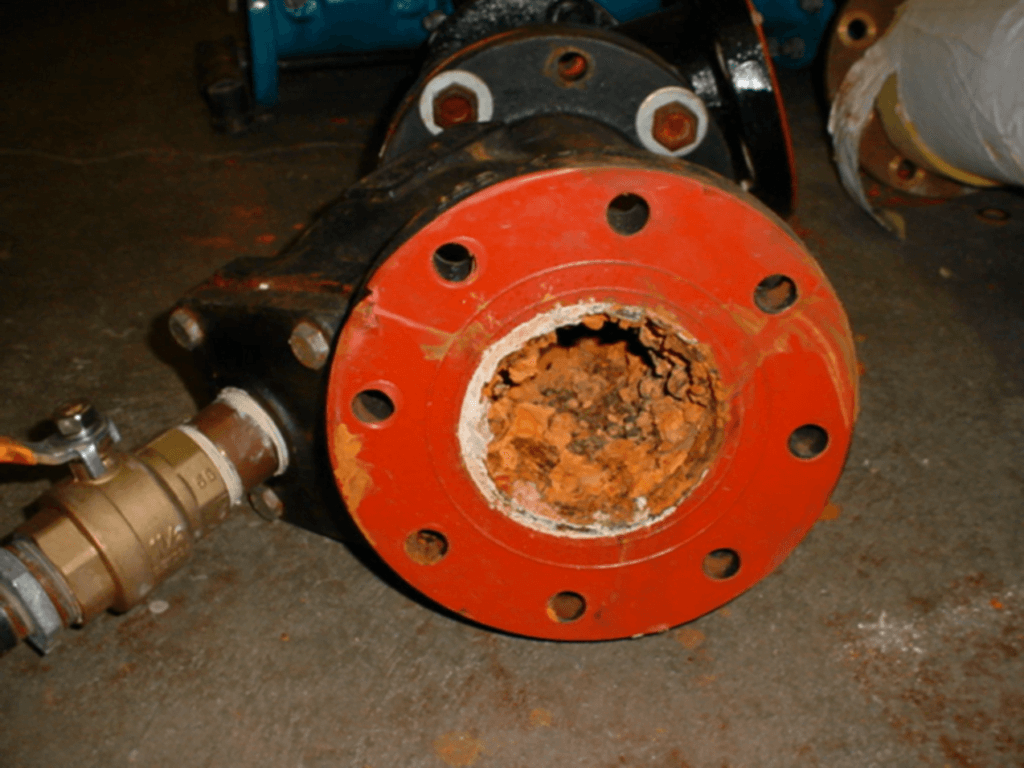

Strainers are also located in warm mechanical rooms, and pose an even BIGGER problem.
- Strainers are designed to trap sediment, a recognized pathogen/bacteria breeding ground.
- Unlike backflow preventers that get tested, strainers usually get NO ATTENTION.
- The ONLY way to clean the basket


- Isolate the strainer
- Unbolt & remove strainer cover
- Remove & clean basket
- Flush the line until the water is clear BEFORE replacing basket.
- Always have a spare basket, as they are prone to rot out.
TIP: In conjunction with installing parallel 2” backflow preventers, install parallel 2” strainers and require that the strainers be cleaned during backflow testing.
3) Expansion Tanks
Also found in warm mechanical rooms, water pressure booster pump systems use expansion tanks. The pictured tank was probably a legionella “hotel”, as the supply line was a mere 1/2” tube (so small it’s tough to see). This piping would NOT allow any turn-over of the tank’s water, and with no turn-over, the tank’s water temperature increases, and becomes stagnant.


TIP: VFD controlled water pressure booster pump systems ramp down to a low speed, so all that’s needed is a small tank (i.e. 30 gallon) with at least a 1” feed line (ASME tanks are only necessary for higher pressures).


4) Water Pressure Booster Pump Systems with small “Jockey pumps”
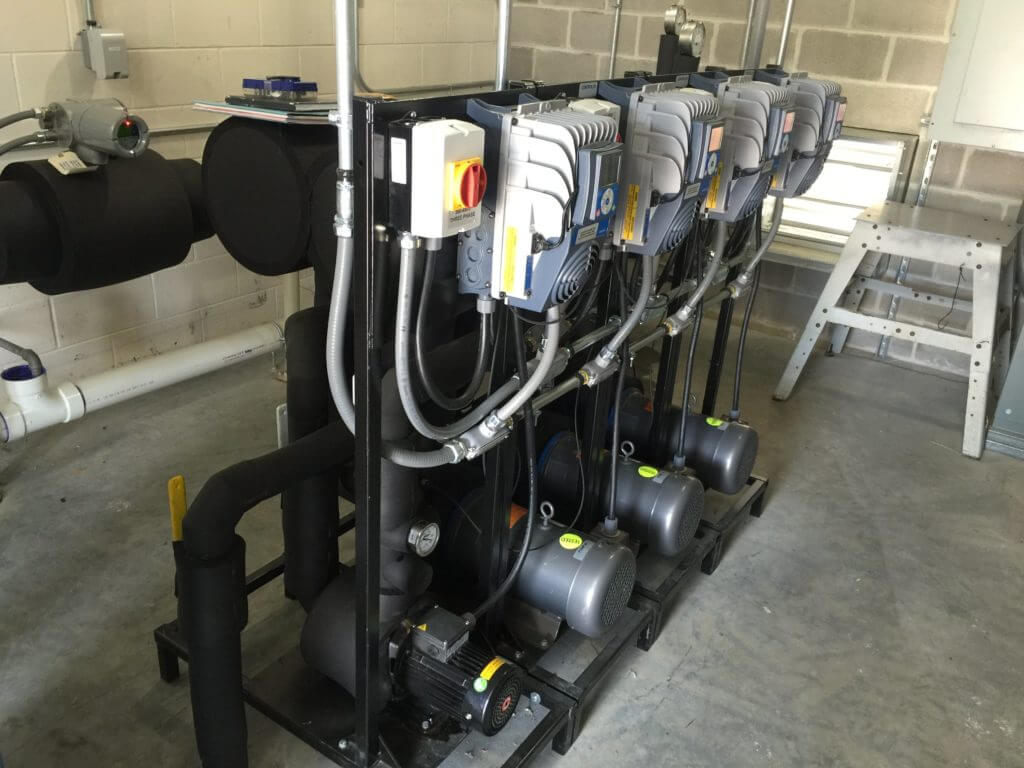

The pictured system (2012 vintage) has a small 2Hp (horsepower) “jockey pump” and three 5Hp “main” pumps.
Theory: To save energy, the small 2Hp pump handles the low water usage, and the large 5Hp pump(s) ramp up for peak demands.
What I’ve witnessed: these systems, like most booster pumps, are usually grossly over-sized, so the only pump that runs is the small “jockey pump”. The result: the large 5Hp pumps remain silent, heat up and produce stagnant water, and becomes a bacteria “harbor”.
In the unfortunate event that the 5Hp pump turns on, ALL of the nasty bacteria-laden water is delivered to the tenants.
Like the previous example when testing parallel backflow preventers, for a health expert investigating an outbreak, this scenario is tough to identify, and tough to prove, as all the evidence is gone from the pump.
TIP: We no longer design systems with “jockey pumps”, but instead design and build triplexes with equal size pumps, including alternating the lead pump every 24 hours.
FEEDBACK: We look forward to feedback. Please review the reference documents, which are the foundation for much of this discussion.
REFERENCE DOCUMENTS
2012 IPC CODE AND COMMENTARY:
108.7: “Unsafe plumbing. Any plumbing that is regulated by this code that is unsafe or that constitutes a fire or health hazard, insanitary condition, or is otherwise dangerous to human life is hereby declared unsafe.
604.3: “pipe sizes using flow rates in Table 604.3 could result in significant and unnecessary over-sizing of piping.”
ASHRAE Standard 188-2015, LEGIONELLOSIS: RISK MANAGEMENT FOR BUILDING WATER SYSTEMS
8.1 Requirements for Designing Building Water Systems; …..”following shall be documented:”
8.1.10; “No-flow and low-flow portions of the piping and building water systems.”
8.1.11; “Impact of ….heat gain by cold water in piping and water system components”
ASHRAE Standard 12-2000: Minimizing the Risk of Legionellosis Associated with Building Water Systems
2.2 ….nonresidential building systems (including but not limited to hotels, office buildings, hospitals, and other health care facilities, assisted living facilities, schools and universities, commercial buildings, industrial buildings, etc.) and centralized systems in multifamily residential buildings.
3.2 Habitats
- Legionellae bacteria are commonly present in natural and man-made aquatic environments.
- Conditions that are favorable for the amplification of legionellae growth include water temperatures of 77-108F, stagnation, scale and sediment, biofilms, and the presence of amoebae.
- Growth in nature in the absence of protozoa and/or in the absence of complex microbial biofilms has NOT been demonstrated.
4.1.2 Design of Plumbing Systems “Growth of legionella may occur in portions of the system with infrequent use, in stagnant water, and in portions of the system with tepid temperatures”
